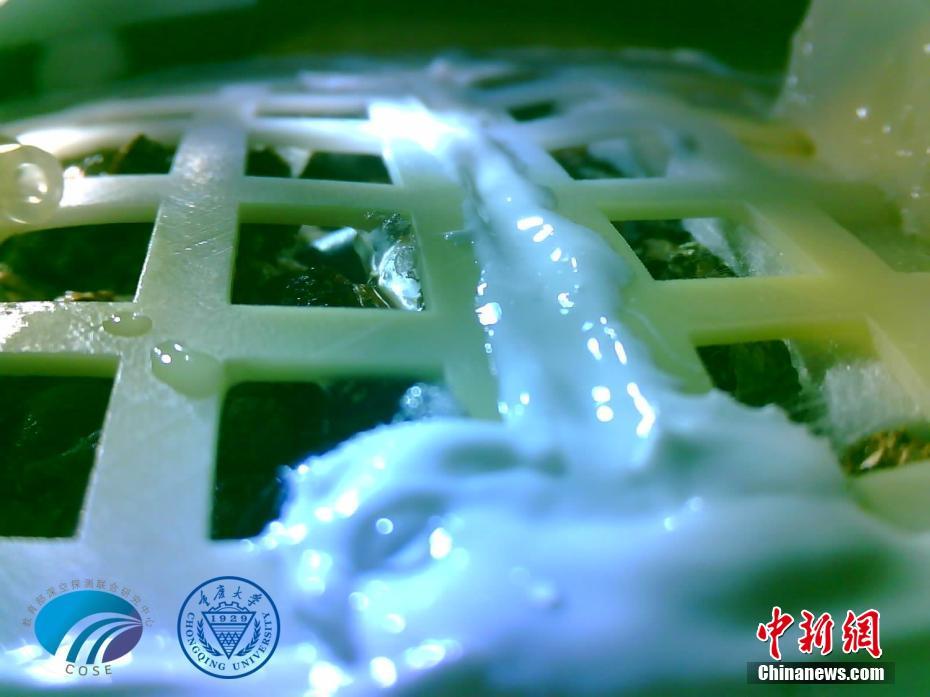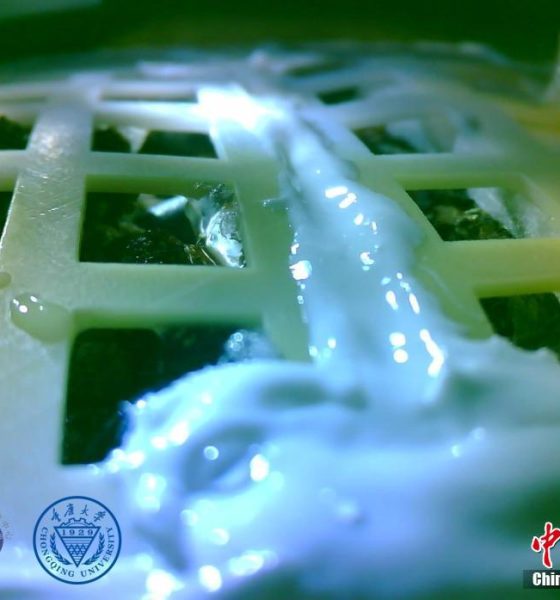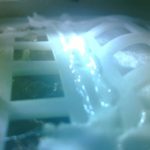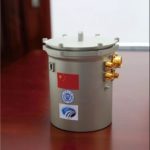

News
China successfully sprouts cotton seeds on the moon in a historic first
International discussions about sending humans to the Moon and Mars have brought many challenges waiting to be solved, and among them is food supply. While astronauts aboard the International Space Station (ISS) have been growing and consuming lettuce in space for a few years now, China has achieved a historic milestone by sprouting cotton seeds on the surface of the Moon. The news and corresponding photos were announced today. The seeds were part of a biosphere experiment which, if it performs as intended, will provide helpful data towards the development of sustainable agriculture in environments other than Earth.
China’s Chang’e 4 craft lunar lander arrived January 3, 2019 on the far side of the Moon, and part of its cargo included an aluminum alloy canister equipped with materials necessary for not only plant growth, but a self-sustaining biological environment lead by Chongqing University. Along with cotton seeds, the experiment included rapeseed, potato, and arabidopsis seeds, as well as fruit fly eggs and yeast to form a simple, tiny biosphere. A heat control system and two cameras were also part of the makeup.
Each member of the experiment was chosen with a bioprocess purpose in mind: Potato seeds represented a primary food supply for future space travelers (see also: The Martian), rapeseed could be used to produce oil, cotton seeds for clothing/supply fabric, the fruit fly would act as the consumer, and the yeast could regulate the oxygen and carbon dioxide being exchanged between the fly and the plants. The arabidosposis seeds contribute via its photosynthesis and could be a food source, but the plant is generally considered to be weed with a short growth cycle that could be useful for observation. The seeds and eggs were kept dormant until their lunar arrival, after which time they were watered by the lander. The germination of the cotton seeds alone has not yet been determined or specified by China’s space agency, the China National Space Administration (CNSA).
UPDATE: CNSA announced later on January 15, 2018 that the cotton sprouts are now dead. As the night period on the far side of the Moon set in, temperatures dropped to a level not sustainable in the biosphere canister.
- The cotton seed sprouts currently living on Earth as a comparable control. | Credit: CNSA/Chongqing University
- The canister containing China’s Chang’e lunar biosphere experiment on the Moon. | Credit: CNSA/Chongqing University
- A diagram of the types of seeds included in the Chang’e lunar biosphere experiment on the Moon. | Credit: CNSA/Chongqing University
Self-sustaining habitable environments for off-planet travel have been part of scientific research for decades, including a famous large-scale experiment conducted almost 30 years ago called Biosphere 2 (Earth is Biosphere 1). On September 26, 1991, 8 researchers were voluntarily sealed into a glass and steel structure on over 3 acres of land in Oracle, Arizona for two years, growing their own food and algae to sustain their living conditions, air included. It was supposed to be a step towards establishing space colonies, but unfortunately, low oxygen and food levels along with infighting (i.e., the human component) rendered the experiment a non-success.
While it’s certainly been determined that human interaction will be a big hurdle for long-term space faring missions, the engineering side of sustainable food production off-Earth is still facing challenges of its own and will continue to need development efforts. For example, astronauts on the ISS are currently working with an orbital agriculture experiment called Veggie which has recently faced issues with plant mold. While on Earth, we’ve become accustomed to the benefits provided by our planet’s natural biosphere – things like humidity, sunlight levels, water levels, etc. work in ways that are difficult to reproduce in a completely controlled environment like a spacecraft.
China’s mini biosphere experiment is another important step towards the long-term goal of sustainable off-planet environments. Given the struggles experienced during biosphere attempts on Earth, there might be a slow growth curve towards developing habitats that don’t need tons of resupply. This challenge is clearly acknowledged by the creators of the Chang’e lunar bio-canister. Professor Liu Hanlong, head of the experiment, stated in the seed sprout announcement, “We have given consideration to future survival in space. Learning about these plants’ growth in a low-gravity environment would allow us to lay the foundation for our future establishment of [a] space base.”

News
Tesla aims to combat common Full Self-Driving problem with new patent
Tesla writes in the patent that its autonomous and semi-autonomous vehicles are heavily reliant on camera systems to navigate and interact with their environment.

Tesla is aiming to combat a common Full Self-Driving problem with a new patent.
One issue with Tesla’s vision-based approach is that sunlight glare can become a troublesome element of everyday travel. Full Self-Driving is certainly an amazing technology, but there are still things Tesla is aiming to figure out with its development.
Unfortunately, it is extremely difficult to get around this issue, and even humans need ways to combat it when they’re driving, as we commonly use sunglasses or sun visors to give us better visibility.
Cameras obviously do not have these ways to fight sunglare, but a new patent Tesla recently had published aims to fight this through a “glare shield.”
Tesla writes in the patent that its autonomous and semi-autonomous vehicles are heavily reliant on camera systems to navigate and interact with their environment.

The ability to see surroundings is crucial for accurate performance, and glare is one element of interference that has yet to be confronted.
Tesla described the patent, which will utilize “a textured surface composed of an array of micro-cones, or cone-shaped formations, which serve to scatter incident light in various directions, thereby reducing glare and improving camera vision.”

The patent was first spotted by Not a Tesla App.
The design of the micro-cones is the first element of the puzzle to fight the excess glare. The patent says they are “optimized in size, angle, and orientation to minimize Total Hemispherical Reflectance (THR) and reflection penalty, enhancing the camera’s ability to accurately interpret visual data.”
Additionally, there is an electromechanical system for dynamic orientation adjustment, which will allow the micro-cones to move based on the angle of external light sources.
This is not the only thing Tesla is mulling to resolve issues with sunlight glare, as it has also worked on two other ways to combat the problem. One thing the company has discussed is a direct photon count.
CEO Elon Musk said during the Q2 Earnings Call:
“We use an approach which is direct photon count. When you see a processed image, so the image that goes from the sort of photon counter — the silicon photon counter — that then goes through a digital signal processor or image signal processor, that’s normally what happens. And then the image that you see looks all washed out, because if you point the camera at the sun, the post-processing of the photon counting washes things out.”
Future Hardware iterations, like Hardware 5 and Hardware 6, could also integrate better solutions for the sunglare issue, such as neutral density filters or heated lenses, aiming to solve glare more effectively.
Elon Musk
Delaware Supreme Court reinstates Elon Musk’s 2018 Tesla CEO pay package
The unanimous decision criticized the prior total rescission as “improper and inequitable,” arguing that it left Musk uncompensated for six years of transformative leadership at Tesla.

The Delaware Supreme Court has overturned a lower court ruling, reinstating Elon Musk’s 2018 compensation package originally valued at $56 billion but now worth approximately $139 billion due to Tesla’s soaring stock price.
The unanimous decision criticized the prior total rescission as “improper and inequitable,” arguing that it left Musk uncompensated for six years of transformative leadership at Tesla. Musk quickly celebrated the outcome on X, stating that he felt “vindicated.” He also shared his gratitude to TSLA shareholders.
Delaware Supreme Court makes a decision
In a 49-page ruling Friday, the Delaware Supreme Court reversed Chancellor Kathaleen McCormick’s 2024 decision that voided the 2018 package over alleged board conflicts and inadequate shareholder disclosures. The high court acknowledged varying views on liability but agreed rescission was excessive, stating it “leaves Musk uncompensated for his time and efforts over a period of six years.”
The 2018 plan granted Musk options on about 304 million shares upon hitting aggressive milestones, all of which were achieved ahead of time. Shareholders overwhelmingly approved it initially in 2018 and ratified it once again in 2024 after the Delaware lower court struck it down. The case against Musk’s 2018 pay package was filed by plaintiff Richard Tornetta, who held just nine shares when the compensation plan was approved.
A hard-fought victory
As noted in a Reuters report, Tesla’s win avoids a potential $26 billion earnings hit from replacing the award at current prices. Tesla, now Texas-incorporated, had hedged with interim plans, including a November 2025 shareholder-approved package potentially worth $878 billion tied to Robotaxi and Optimus goals and other extremely aggressive operational milestones.
The saga surrounding Elon Musk’s 2018 pay package ultimately damaged Delaware’s corporate appeal, prompting a number of high-profile firms, such as Dropbox, Roblox, Trade Desk, and Coinbase, to follow Tesla’s exodus out of the state. What added more fuel to the issue was the fact that Tornetta’s legal team, following the lower court’s 2024 decision, demanded a fee request of more than $5.1 billion worth of TSLA stock, which was equal to an hourly rate of over $200,000.
Delaware Supreme Court Elon Musk 2018 Pay Package by Simon Alvarez
News
Tesla Cybercab tests are going on overdrive with production-ready units
Tesla is ramping its real-world tests of the Cybercab, with multiple sightings of the vehicle being reported across social media this week.

Tesla is ramping its real-world tests of the Cybercab, with multiple sightings of the autonomous two-seater being reported across social media this week. Based on videos of the vehicle that have been shared online, it appears that Cybercab tests are underway across multiple states.
Recent Cybercab sightings
Reports of Cybercab tests have ramped this week, with a vehicle that looked like a production-ready prototype being spotted at Apple’s Visitor Center in California. The vehicle in this sighting was interesting as it was equipped with a steering wheel. The vehicle also featured some changes to the design of its brake lights.
The Cybercab was also filmed testing at the Fremont factory’s test track, which also seemed to involve a vehicle that looked production-ready. This also seemed to be the case for a Cybercab that was spotted in Austin, Texas, which happened to be undergoing real-world tests. Overall, these sightings suggest that Cybercab testing is fully underway, and the vehicle is really moving towards production.
Production design all but finalized?
Recently, a near-production-ready Cybercab was showcased at Tesla’s Santana Row showroom in San Jose. The vehicle was equipped with frameless windows, dual windshield wipers, powered butterfly door struts, an extended front splitter, an updated lightbar, new wheel covers, and a license plate bracket. Interior updates include redesigned dash/door panels, refined seats with center cupholders, updated carpet, and what appeared to be improved legroom.
There seems to be a pretty good chance that the Cybercab’s design has been all but finalized, at least considering Elon Musk’s comments at the 2025 Annual Shareholder Meeting. During the event, Musk confirmed that the vehicle will enter production around April 2026, and its production targets will be quite ambitious.











